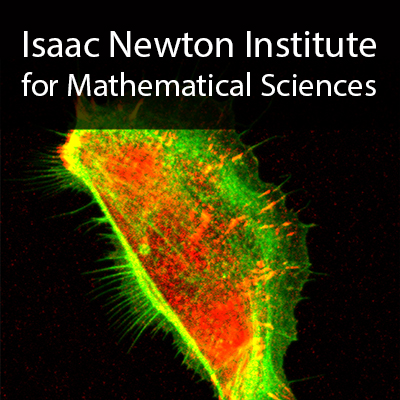Rheology of actomyosin and emergent mechanical properties of cells
51 mins 24 secs,
246.67 MB,
WebM
640x360,
29.97 fps,
44100 Hz,
655.22 kbits/sec
Share this media item:
Embed this media item:
Embed this media item:
About this item

| Description: |
Etienne, J (CNRS [Centre national de la recherche scientifique], Université de Grenoble)
Friday 18th September 2015 - 10:00 to 11:00 |
|---|
| Created: | 2015-09-29 16:55 |
|---|---|
| Collection: | Coupling Geometric PDEs with Physics for Cell Morphology, Motility and Pattern Formation |
| Publisher: | Isaac Newton Institute |
| Copyright: | Etienne, J |
| Language: | eng (English) |
| Distribution: |
World
|
| Explicit content: | No |
| Aspect Ratio: | 16:9 |
| Screencast: | No |
| Bumper: | UCS Default |
| Trailer: | UCS Default |
| Abstract: | Co-authors: Jonathan Fouchard (Univ. Paris-Diderot (now UCL)), Démosthène Mitrossilis (Univ. Paris-Diderot (now Inst. Curie)), Nathalie Bufi (Univ. Paris-Diderot (now Brain & Spine Inst., Paris), Pauline Durand-Smet (Univ. Paris-Diderot (now Caltech)), Atef Asnacios (Univ. Paris-Diderot)
Living cells adapt and respond actively to the mechanical properties of their environment. In addition to biochemical mechanotransduction, evidence exists for a purely mechanical sensitivity to the stiffness of the surroundings at the cell-scale. Using a minimal model that describes the collective behaviour of actin, actin crosslinkers and myosin, we show that the mechanosensitive response of cells spreading between distant elastic microplates is entirely and quantitatively predicted by the behaviour of the actomyosin cortex as a contractile viscoelastic fluid. During this talk, I will present these results [1]: - A simple kinetic model for actin and myosin interaction, leading to a viscoelastic liquid rheology including a source term for myosin action. - The analytical resolution of the statics and dynamics of a thin shell of such a viscoelastic contractile material, which allow to predict quantitatively the behaviour of cells during parallel plates experiments [2-4]. - The significance of this for cell mechanics: the phenomenon of mechanosensitivity can be explained by an intrinsic emergent mechanical behaviour of actomyosin, and the retrograde flow of actin interpreted as a way of regulating cell size. - An analysis of the energy budget of actomyosin during cell contraction: three different mechanisms of dissipation can be identified and quantified. - A comparison of these dissipation mechanisms with the case of the contraction of a whole muscle, as studied experimentally by A. V. Hill [5] and modelled by A. F. Huxley [6]. [1] J. Étienne, et al. Proc. Natl. Acad. Sci. USA, 112:2740-2745, 2015. [2] D. Mitrossilis et al. Proc. Natl. Acad. Sci. USA, 106:18243-18248, 2009. [3] D. Mitrossilis et al. Proc. Natl. Acad. Sci. USA, 107:16518-16523, 2010. [4] K. D. Webster et al. PLoS ONE, 6:e17807, 2011. [5] A. V. Hill. Proc. R. Soc. Lond. B, 126:136-195, 1938. [6] A. F. Huxley. Prog. Biophys. Biophys. Chem., 7:255-318, 1957. Related Links http://www-liphy.ujf-grenoble.fr/pagesperso/etienne/liquidmotors/ - Webpage of Etienne et al 2015 paper http://www-liphy.ujf-grenoble.fr/jocelyn-etienne - J Etienne's page http://www.msc.univ-paris-diderot.fr/~atef_asnacios/index_en.html - A Asnacios's page |
|---|---|
Available Formats
| Format | Quality | Bitrate | Size | |||
|---|---|---|---|---|---|---|
| MPEG-4 Video | 640x360 | 1.93 Mbits/sec | 745.32 MB | View | Download | |
| WebM * | 640x360 | 655.22 kbits/sec | 246.67 MB | View | Download | |
| iPod Video | 480x270 | 522.01 kbits/sec | 196.46 MB | View | Download | |
| MP3 | 44100 Hz | 249.77 kbits/sec | 94.09 MB | Listen | Download | |
| Auto | (Allows browser to choose a format it supports) | |||||

